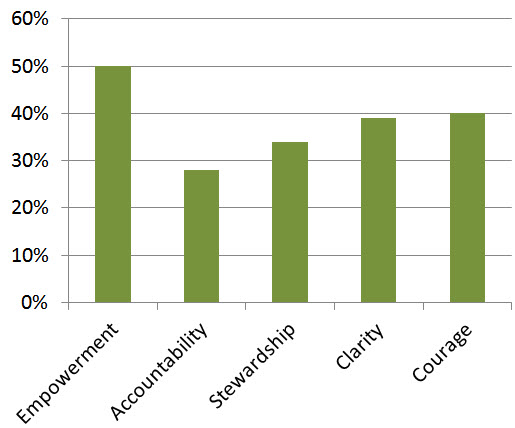Overview
Our original research, published December 2014[1], concerned effective leadership in Life Sciences (LS) organizations with a focus on those developing successful treatments for diseases, medical devices and reliable sources of food. The skills required in these enterprises include virtually every STEM (Science, Technology, Engineering, and Mathematics) discipline. As the world population grows and ages, the importance of their success increases.
Sustainability demands that complex organizations have effective decision makers, but data shows that most organizational life spans are relatively brief. The strongest multinationals only survive about 40 or 50 years, about the same as an Amazonian parrot. This suggests effective decision making is uncommon.
Our mixed-method study involved people working in the Life Sciences (n = 77). The areas of endeavor involved many types of science from biochemistry and bioengineering to imaging and toxicology. What these people have in common is the fact they all work in a fact-based world and the results of their work are important to many. The question for our study was ‘how important is leadership in fostering effective workplace decision making?'

About half the participants (n=34) indicated their primary work was primarily science (could be any STEM discipline) and that group was evenly divided between men and women (the remainder of the 77 worked in the field but their primary focus was commercialization). As a group, STEM workers have an outsize impact on innovation and growth.
Among the STEM workers, the research results identified five leadership behaviors very strongly correlated with direct reports’ effective decision making and development (i.e., growth in capacity to perform). The chart on the left shows the percent of variance for each one -- that is the degree to which each of the leadership behaviors contributes to effective employee decision making and development. In other words, effective decisions are more likely when these behaviors are present.
It’s important to note that as significant as these data may be, research suggests that the impact could be twice as powerful, given a range of responses across the full spectrum.[2] The behaviors are described below:
Empowerment: encapsulates those behaviors which allow and encourage employees to take responsibility for their work, including information sharing, facilitating and encouraging their talents; fostering and supporting a proactive self-confident attitude.
Accountability: holding people and teams accountable for results they can control, showing confidence in employees by placing the responsibility for outcomes in their hands, providing necessary information and boundaries within which they are free to achieve their goals.
Stewardship: placing service above self-interest, behaving ethically with a responsibility for the larger institution, society, and the long-term interest. Setting the right example and modeling desired behaviors are examples of this characteristic.
Clarity: these behaviors combine integrity, an accurate understanding one’s strengths and weaknesses, and the active encouragement of the contributions of others.
Courage: is perceived as the willingness to take risks; including supporting the thoughtful risk taking of others.
Read on to know more. Click here to join a new study.
Effective leadership of Science-based businesses
Our research explored the concept of leadership effectiveness and analyzed the complex systems framework of the adaptive-learning management system (ALMS), and the servant leadership (SL) model. Leadership effectiveness is defined as the ability to generate organizational growth and increased value. The ALMS [3] is a systems-focused leadership process for effective decision making in complex organizations, developed by Russell Ackoff, the world’s foremost systems theorist. Servant Leadership, first codified by Robert Greenleaf, is a set of behaviors intended to empower and develop the individual. These behaviors typically include: empowerment, standing back, accountability, forgiveness, authenticity, humility [clarity], courage and stewardship.
The analysis found that ALMS and servant leadership were theoretically well aligned. This supported Peter Senge’s and Warren Bennis’s suggestion that SL may therefore be the preferred leadership model for complex organizations and/or organizations with a fact-based culture. This in turn led to the empirically tested hypothesis:
In life sciences organizations there is a statistically significant correlation between servant leadership behaviors enacted and direct reports’ effective workplace decision making.
A mixed-method approach measured leadership and decision making behaviors quantitatively. Qualitative data were gathered to enable triangulation.
The total sample (n= 77) produced a positive correlation: r =.48, r2 = .22 (p<.0001). Science-focused participants (n=34) generated a much stronger positive correlation: r = 0.59, r2 =.35 (p<.001) with two behavior factors demonstrating significant variance values: Courage and empowerment measured r2 =.33 and r2 =.39 respectively (p <.0001). Qualitative data also fully supported the hypothesis.
A second hypothesis tested for a statistically significant correlation between the perception of servant leadership behaviors and followers’ participation in workplace effective decision making that enables their development (i.e., capacity). The results also demonstrated a powerful positive correlation. Key servant leadership behaviors influencing decision making and development were found to be empowermentr2 =.50 (<.0001); courage, r2 =.40 (<.0001); humility (clarity) r2 =.39 (<.0001); stewardship r2 =.34 (0.0003) and accountability r2 =.28 (<.00013).
This empirical study is the first to show the correlation of servant leadership and systems-focused management theory. It lends credence to suggestions made by Senge [4], Bass[5] and others that servant leadership is beneficial to organizational sustainability. More importantly, it provides evidence that leaders who practice SL enable people to grow in their capacity to be effective decision makers and, in turn, strengthen their organizations.
We have now launched phase 2 of the STEM leadership study. It will attempt to replicate the initial findings and determine whether there is evidence of a causal relationship between SL leadership behaviors and effective decision making, which may contribute to individual development and organizational sustainability. Is your team interested in participating in this study?
[1] Suss, D.R., 2014
[2] Wiberg & Sundstrom, 2009
[3]Ackoff, R.L. 1999
[4] Senge, P., 1990
[5] Bass,B.M. , 2000
